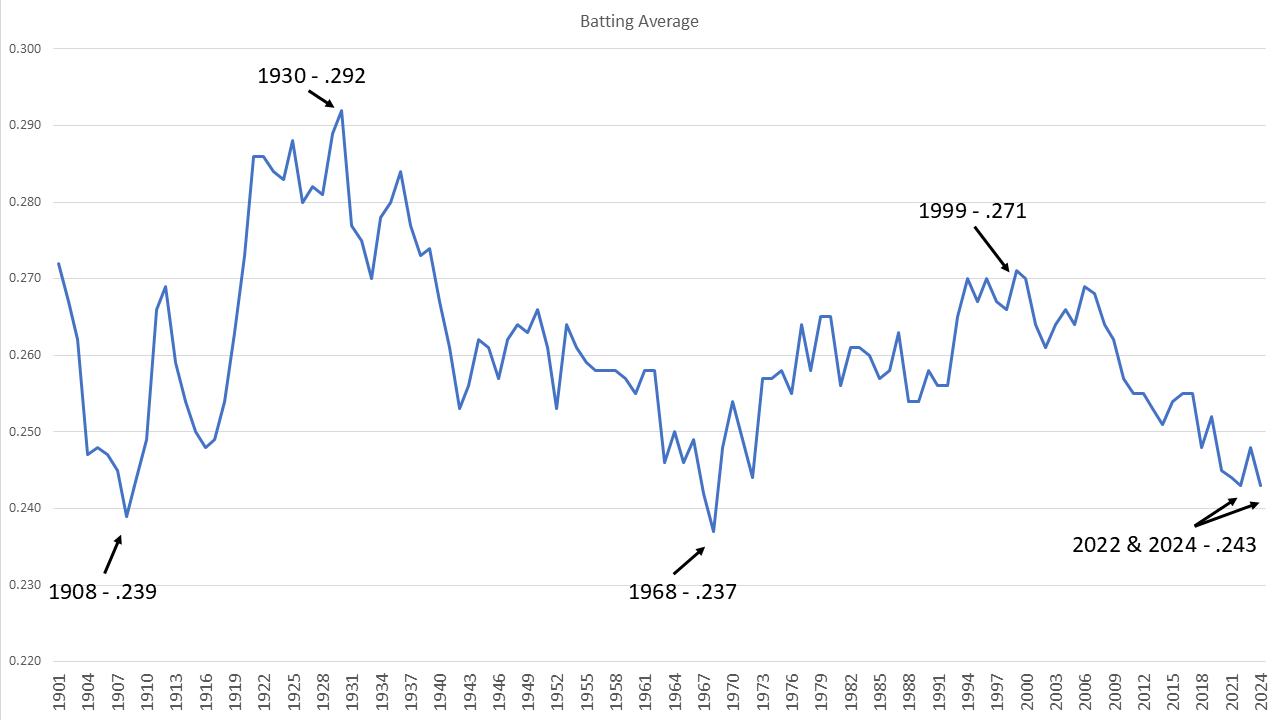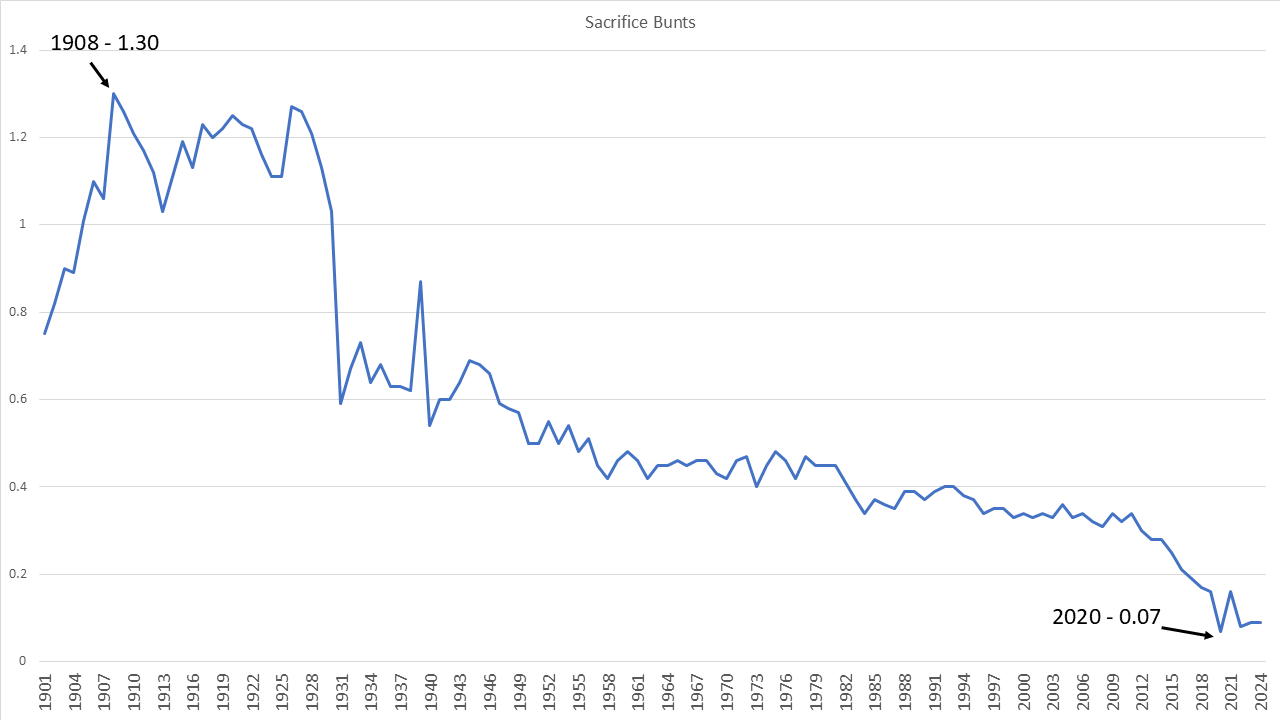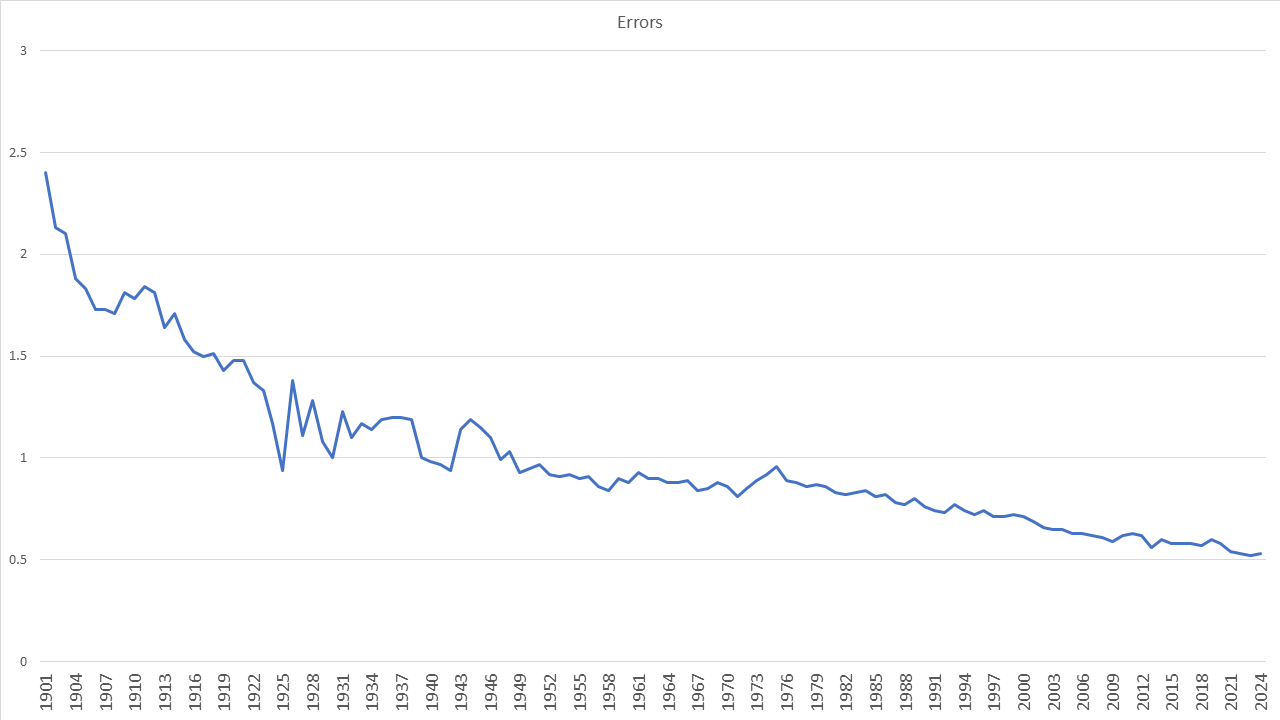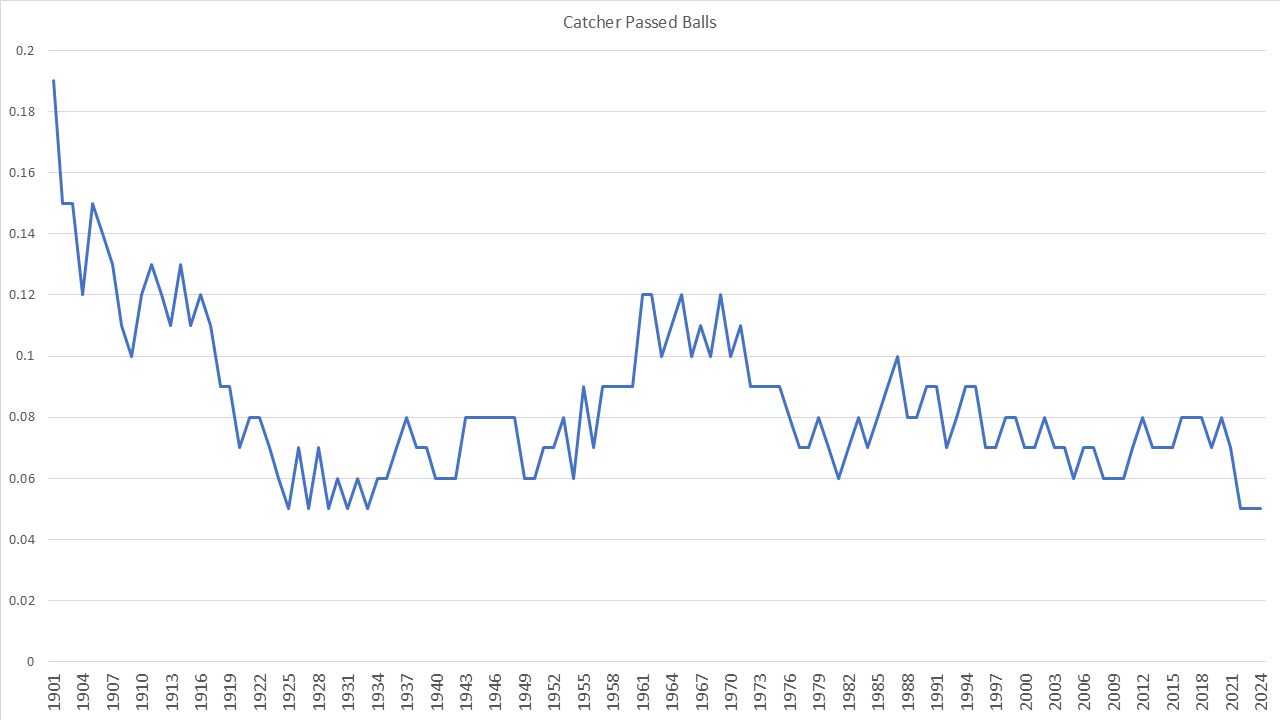Overall 2024 MLB Stats in Historical Context
How do 12 typical batting, pitching, and fielding statistics compare with historical trends? And which stat set a new all-time record?
Issue #201
For this analysis I'm going to be looking at rate statistics, so that shortened seasons like 1981, 1994, 1995, and 2020 can be included, and we can also compare trends going far back, before the current 162-game schedule was established. So by rate, all numbers in this article are stats "per team, per game," and are obtained from Baseball Reference—see these batting, pitching, and fielding tables. I created the charts myself, with the first one (HR) going back to 1871. The others go back to 1901, because some numbers were extremely different prior to that start of "modern baseball," and in some cases we lack the statistics altogether. (Note: the totals used here for "major leagues" now also include the various negro leagues that were recognized as having "major league" status.)
Home Runs
In 2024 there were 1.12 HR per team, per game—a bit less than the 1.21 HR rate we saw in 2023, but higher than the 1.07 HR rate from 2022. I’ve labelled in the chart below various relative highs and lows for HR going back all the way to 1871. Yes, the PED era saw an uptick in HR as compared with the 1970s and 1980s. But since then the use of advanced analytics, and especially the focus on launch angle and exit velocity, has led to more and more HRs being hit overall, with a record set in 2019 of 1.39 HR per team, per game.
Runs
As shown below, the level of runs scored per team, per game has fluctuated a lot over the years since 1901. The average across all 30 teams in 2024 was 4.39, lower than every season since 2015 with the exception of 2022. And the 2024 average is dramatically lower than the recent high of 5.14 in 2000, and the all-time high in 5.49 in 1930. But it remains well above many seasons from the 1960s and 1970s, including of course the 1968 “Year of the Pitcher” which saw a paltry 3.42 runs scored per team, per game.
Earned Run Average
Closely related to total runs scored is of course pitching ERA (not all runs are “earned", but as you can see from the chart below, the historical graph here has similar highs and lows.) In 2024 the average ERA across all 30 teams was 4.07, down a bit from 2023 (4.33), but higher than the 3.96 mark in 2022.
Batting Average
While no longer as revered as it once was, most baseball fans still track batting average with some interest. As shown below, we’ve seen a decline in overall batting average since the early 2000s, with 2024 coming in at .243, which tied the .243 mark we had in 2022. Yes, there have been a few lower seasons throughout MLB history, such as .237 in 1968 and .239 in 1908. But it is also worth noting that the majors had an overall average of .270 or higher every year from 1920-1939, and an overall average of .260 or higher every year from 1993-2009.
While the 2024 AL batting leader was Bobby Witt Jr. with a solid .332 average, the NL leader, Luis Arráez, had a less impressive .314 mark. What I found most interesting is that 2024 was the first season since the anomalous 1968 campaign in which fewer than 10 qualifying batters managed to hit .300 or higher. We only had seven such batters in 2024:
.332 - Bobby Witt Jr.
.323 - Vladimir Guerrero Jr.
.322 - Aaron Judge
.314 - Luis Arráez
.310 - Shohei Ohtani
.308 - Yordan Alvarez
.302 - Marcell Ozuna
Stolen Bases
The trend towards fewer and fewer stolen bases does appear to be over, as the uptick we saw in 2022 turned into a surge in 2023 that was then extended further in 2024. This year we saw 0.74 SB per team, per game—the most since 1992 (0.77). What felt like a trend that might lead us back to the very low SB numbers we saw in the 1950s now seems to have been reversed. There are a few reasons for this, including the rule changes that limit how often pitchers can throw over to first base, and also the increased size of the bases themselves.
Another factor is that the overall caught-stealing % for catchers dropped rather dramatically in 2023 to an all-time low of 19.8% in 2023, before recovering a bit to 21.0% in 2024 (still the second all-time lowest rate.)
Triples
Serious baseball fans know that there used to be a lot more triples hit by batters—especially in the era before Babe Ruth led the surge in HR. Although the triples rate was a bit higher in 2023 and 2024 than in 2020-2022, as the chart shows below, we are essentially still at the end of a longstanding trend downwards. For fans of triples, in 2024 we did have four players with 10+ triples for the first time since 2019. And two players—Corbin Carroll and Jarren Duran—had 14 triples each, the highest player total since Charlie Blackmon’s 14 in 2017.
Sacrifice Bunts
Like triples, another part of the game that has seen a long decline is sacrifice bunts. Far more common in the early 1900s, after the rise of HRs in the 1920s and 1930s, the bunt started a long downward trend leading to a new record low of 0.07 per team, per game in the COVID-shortened 2020 season. With pitchers no longer hitting in the NL, I wouldn’t predict a change in this area for a while (if ever.)
Strikeouts
While triples and sacrifice bunts have long been trending downward, strikeouts have generally been trending up for many years. In 2024 there were 8.48 strikeouts per team, per game—as shown below, that is a bit off the all-time high of 8.81 seen in 2019, but still a very high level in historical context.
Complete Games
The increase in strikeouts has many drivers—hitters swinging for the fences, pitchers creating ever more effective pitches and mixes of pitch types, and the 50-year growth of specialized relievers who are increasingly throwing max effort with seemingly every pitch. The growth of such bullpens has also meant—for better or worse—that starting pitchers are rarely expected to go 7 or more innings, not to mention completing a game.
Indeed, 2024 set a new record for the fewest complete games in MLB history. I don’t just mean the complete game rate, which as shown below was again 0.01 per team, per game. No I mean a record for total complete games thrown—including even the very short 2020 season! In 2024 there were only 28 total complete games thrown, well under the 35 in 2023, the 50 as recently as 2021—and even one less than the 29 in the COVID-shortened 2020 season!
Also of note, 2024 was the first season ever with only three pitchers with two complete games each: Kevin Gausman, Cristopher Sánchez, and Max Fried. And to think, in the early 1900s the majority of games saw a complete game pitched by at least one of the two starters.
Errors
I'm not going to delve into fielding statistics too far, but it seems worth celebrating that the rate of errors per team, per game continues to be at or near all-time lows. The record was 0.52 in 2023, just a tick better than the 0.53 rate in both 2022 and 2024. That figure was 0.70 or higher every year prior 2001, and over 0.80 every year prior to 1987.
Some of this slow decline in errors is no doubt the result of ever better fielding equipment (gloves), better defensive techniques, and so on. But it is interesting to note that fielding assists are also at an all-time low the past five seasons, with the 8.53 assists per team, per game being the lowest rate ever other than the 8.50 mark set in the short 2020 season. Are players being more conservative lately and therefore getting less assists but also committing fewer errors? Maybe. Are scoring officials, for whatever reasons, giving out fewer errors? Maybe. But I assume the main reason that assists are lower is because of the increased focus on launch angle and hitting HRs. This leads to fewer groundballs and more flyballs—which I assume would correlate to some degree with fewer fielding assists, and also fewer errors (since more errors are committed in the infield than the outfield.)
Catcher Passed Balls
Lastly... as noted earlier, catchers have hit new record lows in throwing out baserunners the past two years. Where catchers have done better is in not allowing passed balls. The rate of only 0.05 per team, per game is the same record low we saw in both 2022 and 2023 (and also in several years from 1925-1933). The raw total of passed balls in 2024 (238) was slightly higher than in 2023 (232) and 2022 (231). But I don’t see it increasing dramatically until if/when we see more knuckleball pitchers in the game.
All data is from Baseball-Reference.com.
















Nice work Tom.